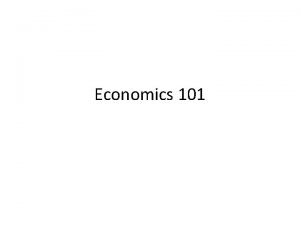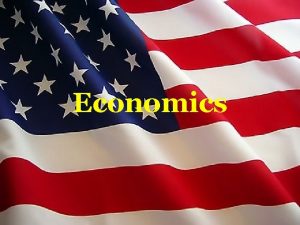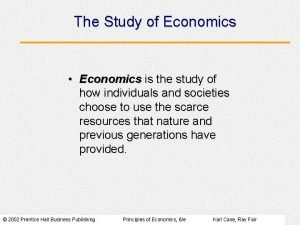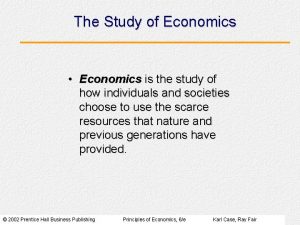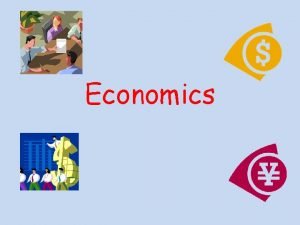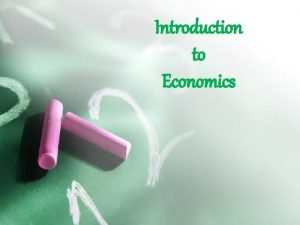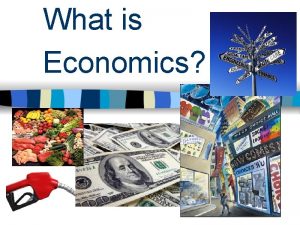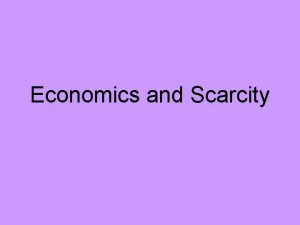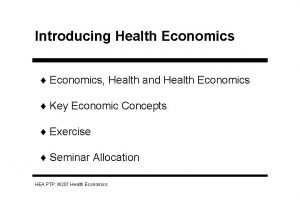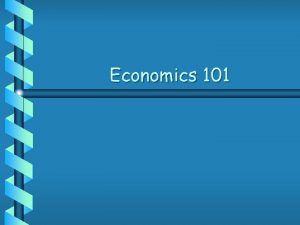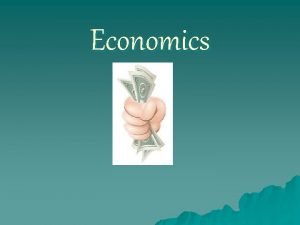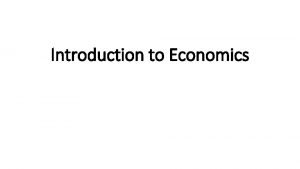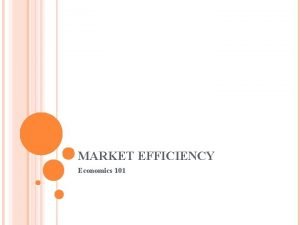AP Economics Module 1 The Study of Economics




















- Slides: 20

AP Economics Module 1 The Study of Economics

Main Ideas • How scarcity and choice are central to the study of economics • The importance of opportunity cost in individual choice and decision making • The difference between positive economics and normative economics • When economists agree and why sometimes disagree • What makes macroeconomics different from microeconomics

Individual Choice: The Core of Economics • • • Economics Individual choice Economy Market economy Property rights Marginal analysis

I. Individual Choice Economics: The social science concerned with the efficient use of limited or scarce resources to achieve maximum satisfaction of human economic wants. Economics is the study of scarcity and choice. Every economic issue involves, at its most basic level, individual choice—decisions by individuals about what to do and what not to do

I. Individual Choice A. Market and Command Economies Different societies have developed different ways in which the economy confronts scarcity. • Market economy: production and consumption are the result of decentralized decisions by many firms and individuals. • Command economy: industry is publicly owned and there is a central authority making production and consumption decisions.

I. Individual Choice Most nations, like the U. S. , have adopted primarily a market economy. Why have most command economies failed the test of history and market economies have succeeded? There are two primary reasons for the success of markets. 1. Incentives. A price is a powerful incentive. Example Suppose there is such strong demand for corn that a shortage of corn exists and the market price begins to rise. A higher price of corn gives farmers an incentive to produce more corn and to profit from the sale. This incentive, created by a higher market price, eliminates the shortage. Example Suppose there is a shortage of doctors. In the labor market for doctors, wages will begin to rise. Higher wages will provide an incentive for college students to pursue medical school and eventually supply more doctors to this labor market, eliminating the shortage of doctors.

I. Individual Choice 2. Property Rights In a command economy, the government owns the resources or property. So a farmer doesn’t own his own land, the land is owned by the government. DISCUSSION: Why would a farmer take good care of his land if it wasn’t his land to begin with? Why would the president of a company take good care of her factory and machinery if those capital resources were owned by the government? She is unlikely to produce a high quality product, or invest in new and better ways of producing those goods, if she cannot enjoy the rewards from those investments.

I. Individual Choice 2. Property Rights In a command economy, the government owns the resources or property. So a farmer doesn’t own his own land, the land is owned by the government.

I. Individual Choice B. Resources are Scarce What exactly are these resources? labor (the effort of workers), land (including timber, water, minerals, and all other resources that come from nature), capital (machinery, buildings, tools, and all other manufactured goods used to make other goods and services) entrepreneurship (risk taking, innovation, and the organization of resources for production).

LABOR LAND Resource Utilization: A Lemonade Stand CAPITAL ENTREPRENEUR

I. Individual Choice B. Resources are Scarce Wants vs. Needs—What’s the difference? Wants: limitless and varied. Ex. golf clubs, a college degree, Tivo. Needs (a subset of wants): clean air, clean water, food, clothing, and shelter. Economic resources are limited/scarce which implies that the goods/services they produce must be limited. Scarcity requires that choices be made. Choices imply that things are given up. Example The size of the school parking lot is limited, which means only a certain number of cars can be parked there. If the parking lot were to be expanded, without purchasing more land, what would be sacrificed? Example A hydroelectric dam is being planned for a river. Many costly resources will be required to build this dam. Those resources could have been used in other projects. So a bridge over a scenic wild river, or a new highway was sacrificed. By damming the river, we also give up goods and services that could have been generated by the undammed river. Maybe guided whitewater rafting was sacrificed. These sacrifices are called opportunity costs. To get more of one thing, you forgo the opportunity of getting something else. The cost of the dam is the value of all that which is sacrificed to obtain it.

I. Individual Choice B. Resources are Scarce What about “free” stuff? Why would anything be FREE? Advertisements, coupling a purchased item with another item, to increase demand, etc… What is the difference between buy one get one free and everything half price?

I. Individual Choice C. Marginal Analysis Opportunity Cost and Marginal Analysis Opportunity Cost: The Real Cost of Something is What You Must Give Up to Get It As the above examples illustrate, decisions made in the face of scarce resources involve bypassing other opportunities and these forgone opportunities have value, or cost. Example Suppose you purchase a digital camera that costs $100, and you decided not to buy a pair of running shoes that also cost $100. The opportunity cost of buying the camera is $100, plus the forgone enjoyment of the running shoes. Discussion: What are some of the direct and indirect costs of participating in an after school activity? What if you had to pay for the activity? What would you be willing to pay?

I. Individual Choice Marginal Analysis Economics is goverened by a type of thinking called MARGINAL ANALYSIS. The marginal benefit should always exceed the marginal cost. Marginal Analysis Many of our decisions are made on an incremental basis. Example: A person might consider whether he or she should spend another hour on Facebook. If the person believes that the additional benefits received (enjoyable communication with friends) from this activity outweigh the additional costs incurred (like a poor grade on tomorrow’s geometry quiz), then the person will spend another hour on Facebook. These additional benefits are called “marginal benefits”. The additional costs are called “marginal costs”. Economists assume that people will choose actions only if the marginal benefits at least outweigh the mmarginal costs. In other words, if MB >= MC, do it. If MB < MC, do not

II. Microeconomics vs. Macroeconomics Microeconomics: The branch of economics concerned with how individuals make decisions and how these decisions interact. Microeconomics focuses on choices made by individuals, households, or firms—the smaller parts that make up the economy as a whole. Macroeconomics: The branch of economics that studies the overall ups and downs of the economy. Macro focuses on economic aggregates—economic measures such as the unemployment rate, the inflation rate, and gross domestic product—that summarize data across many different markets. Macroeconomics focuses on the bigger picture.

III. Positive and Normative Economics Positive economics: Economic analysis used to answer questions about the way the world works. Statements of “what is” or “what will be. ” No value judgments are applied. Normative economics: economic analysis that involves saying how the world should work. Statements of “what should be. ” These involve value judgments of what is “right, ” “wrong, ” or “best. ”

Build a Zoo Build a zoo! Groups of 3 -5 and build a zoo. Each group has 20 acres to use, and each exhibit takes up a certain number of acres (see Handout below). After the zoo is constructed, share your choices.

Build a Zoo 20 Acres Maximum!

Build a Zoo After the zoo is constructed, share your choices. Why did you not choose every type of exhibit? SCARCITY Why did you not just have a zoo full of predators or primates? DIMINISHING MARGINAL UTILITY Why did you choose one exhibit over another? COST VS. BENEFIT What was the last exhibit to make the cut? MARGINAL ANAYSIS

Review of Main Ideas Key Economic Concepts For This Module: • Economic resources are limited/scarce which implies that the goods/services they produce are limited. • Scarcity requires that choices be made. • Choices imply that things are given up. • There is an opportunity cost for all choices. • Many decisions are based upon a comparison of the marginal benefits received and the marginal costs incurred. Economists refer to this approach as marginal analysis.
 C device module module 1
C device module module 1 Ap economics module 1
Ap economics module 1 Marine biology module 3 study guide
Marine biology module 3 study guide What is the importance of dom in the epipelagic?
What is the importance of dom in the epipelagic? Hát kết hợp bộ gõ cơ thể
Hát kết hợp bộ gõ cơ thể Lp html
Lp html Bổ thể
Bổ thể Tỉ lệ cơ thể trẻ em
Tỉ lệ cơ thể trẻ em Chó sói
Chó sói Chụp phim tư thế worms-breton
Chụp phim tư thế worms-breton Chúa yêu trần thế
Chúa yêu trần thế Các môn thể thao bắt đầu bằng tiếng nhảy
Các môn thể thao bắt đầu bằng tiếng nhảy Thế nào là hệ số cao nhất
Thế nào là hệ số cao nhất Các châu lục và đại dương trên thế giới
Các châu lục và đại dương trên thế giới Công thức tiính động năng
Công thức tiính động năng Trời xanh đây là của chúng ta thể thơ
Trời xanh đây là của chúng ta thể thơ Cách giải mật thư tọa độ
Cách giải mật thư tọa độ Làm thế nào để 102-1=99
Làm thế nào để 102-1=99 Phản ứng thế ankan
Phản ứng thế ankan Các châu lục và đại dương trên thế giới
Các châu lục và đại dương trên thế giới Thơ thất ngôn tứ tuyệt đường luật
Thơ thất ngôn tứ tuyệt đường luật

























